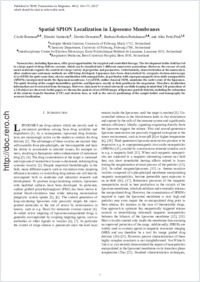Spatial SPION localization in liposome membranes
- Bonnaud, Cécile Adolphe Merkle Institute, University of Fribourg, Marly, Switzerland - Chemistry Department, University of Fribourg, Switzerland
- Vanhecke, Dimitri Adolphe Merkle Institute, University of Fribourg, Marly, Switzerland
- Demurtas, Davide Interdisciplinary Center for Electron Microscopy, École Polytechnique Fédérale de Lausanne, Switzerland
- Rothen-Rutishauser, Barbara Adolphe Merkle Institute, University of Fribourg, Marly, Switzerland - Respiratory Medicine, Bern University Hospital, Switzerland
- Petri-Fink, Alke Adolphe Merkle Institute, University of Fribourg, Marly, Switzerland - Chemistry Department, University of Fribourg, Switzerland
-
21.01.2012
Published in:
- IEEE Transactions on Magnetics. - 2012, vol. 49, no. 1, p. 166-171
English
Nanocarriers, including liposomes, offer great opportunities for targeted and controlled therapy. The development in this field has led to a large panel of drug delivery systems, which can be classified into 3 different nanovector generations. However, the success of such smart materials requires the control of a large variety of properties and parameters. Unfortunately, characterization at the nanoscale is often cumbersome and many methods are still being developed. Liposomes have been characterized by cryogenic electron microscopy (CryoTEM) for quite some time, also in combination with nanoparticles, in particular with superparamagnetic iron oxide nanoparticles (SPIONs) incorporated inside the liposomal membrane. CryoTEM, unlike classical TEM, maintains the native state of the liposomes. The quick freezing of the sample immobilizes particles and liposomes exactly at their position in the suspension. Therefore, localization information can be extracted from the images. However, data must be treated extremely carefully keeping in mind that 2-D projections of a 3-D object are observed. In this paper, we discuss the analysis of cryoTEM images of liposome-particle hybrids, including the estimation of the contrast transfer function (CTF) and electron dose, as well as the correct positioning of the sample holder and tomography for accurate localization.
- Faculty
- Faculté des sciences et de médecine
- Department
- Département de Chimie
- Language
-
- English
- Classification
- Chemistry
- License
-
License undefined
- Identifiers
-
- RERO DOC 31161
- DOI 10.1109/TMAG.2012.2219040
- Persistent URL
- https://folia.unifr.ch/unifr/documents/302835
Statistics
Document views: 150
File downloads:
- pdf: 226
